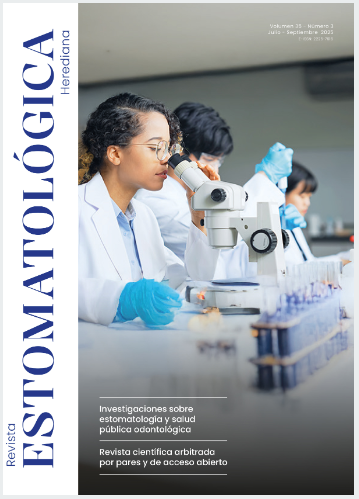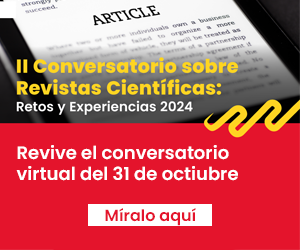Mandibular advancement devices as a treatment for obstructive sleep apnea: a literature review
DOI:
https://doi.org/10.20453/reh.v35i3.5989Keywords:
sleep apnea, obstructive sleep apnea, apnea, mandibular advancement deviceAbstract
Obstructive sleep apnea (OSA) is a sleep disorder resulting from the narrowing and collapse of the upper airway. It has been associated with an increased risk of motor vehicle accidents, diabetes, and cardiovascular diseases, making it a major public health issue. In recent years, intraoral mandibular advancement devices have gained popularity as an option for the treatment of snoring and OSA. These devices are well tolerated by most patients, and their therapeutic efficacy has been widely demonstrated. Against this background, it is important to know the advantages of their use, the treatment protocol, and their possible side effects.
Downloads
References
Heinzer R, Marti-Soler H, Haba-Rubio J. Prevalence of sleep apnoea syndrome in the middle to old age general population. Lancet Respir Med [Internet]. 2016; 4(2): e5-e6. Disponible en: https://dx.doi.org/ 10.1016/S2213-2600(16)00006-0
Bartolucci ML, Bortolotti F, Corazza G, Incerti S, Paganelli C, Alessandri G. Effectiveness of different mandibular advancement device designs in obstructive sleep apnoea therapy: a systematic review of randomised controlled trials with meta-analysis. J Oral Rehabil [Internet]. 2021; 48(4): 469-486. Disponible en: https://doi.org/10.1111/joor.13077
Wojda M, Jurkowski P, Lewandowska A, Mierzwińska-Nastalska E, Kostrzewa-Janicka J. Mandibular advancement devices in patients with symptoms of obstructive sleep apnea: a review [Internet]. En: Pokorski M, editor. Medical Science and Research. Advances in Experimental Medicine and Biology. Cham: Springer; 2019. pp. 11-17. Disponible en: https://doi.org/10.1007/5584_2019_334
Douglas NJ, Polo O. Pathogenesis of obstructive sleep apnoea/hypopnoea syndrome. Lancet [Internet]. 1994; 344(8923): 653-655. Disponible en: https://doi.org/10.1016/s0140-6736(94)92088-5
Francis CE, Quinnell T. Mandibular advancement devices for OSA: an alternative to CPAP? Pulm Ther [Internet]. 2021; 7(1): 25-36. Disponible en: https://doi.org/10.1007/s41030-020-00137-2
Hudgel DW. Mechanisms of obstructive sleep apnea. CHEST [Internet]. 1992; 101(2): 541-549. Disponible en: https://doi.org/10.1378/chest.101.2.541
Sharples LD, Clutterbuck-James AL, Glover MJ, Bennett MS, Chadwick R, Pittman MA, et al. Meta-analysis of randomised controlled trials of oral mandibular advancement devices and continuous positive airway pressure for obstructive sleep apnoea-hypopnoea. Sleep Med Rev [Internet]. 2016; 27: 108-124. Disponible en: https://doi.org/10.1016/j.smrv.2015.05.003
Olivi H. Apnea del sueño: cuadro clínico y estudio diagnóstico. Rev Méd Clín Las Condes [Internet]. 2013; 24(3): 359-373. Disponible en: https://doi.org/10.1016/S0716-8640(13)70173-1
Lloberes P, Durán-Cantolla J, Martínez-García MÁ, Marín JM, Ferrer A, Corral J, et al. Diagnóstico y tratamiento del síndrome de apneas-hipopneas del sueño. Arch Bronconeumol [Internet]. 2011; 47(3): 143-156. Disponible en: https://doi.org/10.1016/j.arbres.2011.01.001
Sleep-related breathing disorders in adults: recommendations for syndrome definition and measurement techniques in clinical research. Sleep [Internet]. 1999; 22(5): 667-689. Disponible en: https://doi.org/10.1093/sleep/22.5.667
Practice parameters for the treatment of snoring and obstructive sleep apnea with oral appliances. Sleep [Internet]. 1995; 18(6): 511-513. Disponible en: https://doi.org/10.1093/sleep/18.6.511
Simonds AK. New developments in the treatment of obstructive sleep apnoea. Thorax [Internet]. 2000; 55(suppl 1): S45-S50. Disponible en: https://doi.org/10.1136/thorax.55.suppl_1.s45
Monasterio C, Navarro A, Brinquis T, Estopà R, Manresa F, Farreras S, et al.. Eficacia de una prótesis de avance mandibular en el tratamiento del síndrome de apneas obstructivas del sueño. Arch Bronconeumol [Internet]. 2000; 36(7): 371-376. Disponible en: https://doi.org/10.1016/S0300-2896(15)30136-8
Ramar K, Dort LC, Katz SG, Lettieri CJ, Harrod CG, Thomas SM, et al. Clinical practice guideline for the treatment of obstructive sleep apnea and snoring with oral appliance therapy: an update for 2015. J Clin Sleep Med [Internet]. 2015; 11(7): 773-827. Disponible en: https://doi.org/10.5664/jcsm.4858
Pitsis AJ, Darendeliler MA, Gotsopoulos H, Petocz P, Cistulli PA. Effect of vertical dimension on efficacy of oral appliance therapy in obstructive sleep apnea. Am J Respir Crit Care Med [Internet]. 2002; 166(6): 860-864. Disponible en: https://doi.org/10.1164/rccm.200204-342OC
Sakamoto Y, Furuhashi A, Komori E, Ishiyama H, Hasebe D, Sato K, et al. The most effective amount of forward movement for oral appliances for obstructive sleep apnea: a systematic review. Int J Environ Res Public Health [Internet]. 2019; 16(18): 3248. Disponible en: https://doi.org/10.3390/ijerph16183248
Ghazal A, Sorichter S, Jonas I, Rose EC. A randomized prospective long-term study of two oral appliances for sleep apnoea treatment. J Sleep Res [Internet]. 2009; 18(3): 321-328. Disponible en: https://doi.org/10.1111/j.1365-2869.2009.00738.x
Bloch KE, Iseli A, Zhang JN, Xie X, Kaplan V, Stoeckli PW, et al. A randomized, controlled crossover trial of two oral appliances for sleep apnea treatment. Am J Respir Crit Care Med [Internet]. 2000; 162(1): 246-251. Disponible en: https://doi.org/10.1164/ajrccm.162.1.9908112
Durán-Cantolla J, Crovetto-Martínez R, Alkhraisat MH, Crovetto M, Municio A, Kutz R, et al. Efficacy of mandibular advancement device in the treatment of obstructive sleep apnea syndrome: a randomized controlled crossover clinical trial. Med Oral Patol Oral Cir Bucal [Internet]. 2015; 20(5): e605-e615. Disponible en: http://doi.org/doi:10.4317/medoral.20649
Addy N, Bennett K, Blanton A, Dort L, Levine M, Postol K, et al. Policy statement on a dentist’s role in treating sleep-related breathing disorders. J Dent Sleep Med [Internet]. 2018; 5(1): 25-26. Disponible en: http://dx.doi.org/10.15331/jdsm.6920
Downloads
Published
How to Cite
Issue
Section
License
Copyright (c) 2025 Gina Maritza Laquihuanaco Coarita, Lidia Yileng Tay Chu Jon

This work is licensed under a Creative Commons Attribution 4.0 International License.
The authors retain the copyright and cede to the journal the right of first publication, with the work registered with the Creative Commons License, which allows third parties to use what is published as long as they mention the authorship of the work, and to the first publication in this journal.























